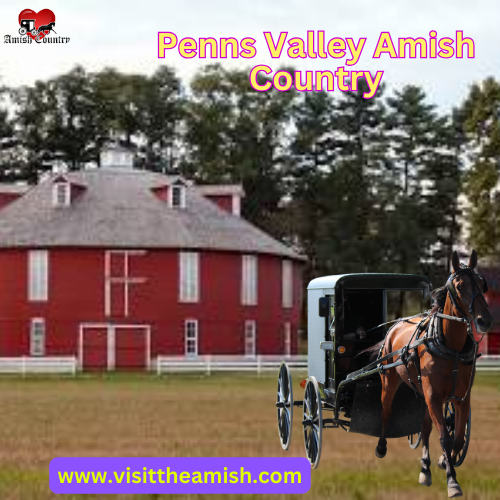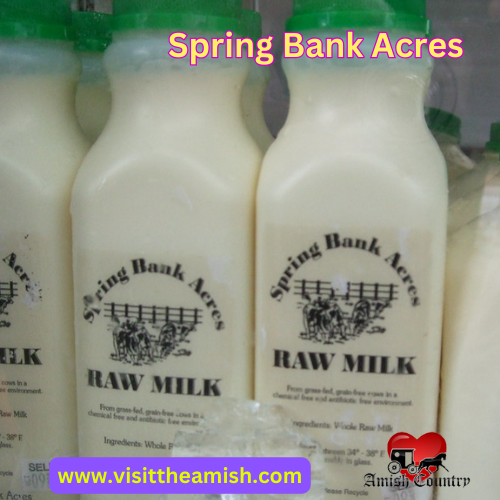Immerse Yourself in Penns Valley Amish Country: A 24-Hour Itinerary
Penns Valley, nestled amidst the rolling hills of Centre County, Pennsylvania, offers a captivating glimpse into a bygone era. Here, time seems to slow down as you encounter Amish buggies traversing scenic country roads, fertile farmlands stretching towards the horizon, and a palpable sense of community.
This itinerary is designed to be your guide for a delightful 24-hour exploration of Penns Valley Amish Country, taking you through historical sites, natural wonders, and charming small towns.
Morning:
- Scenic Drive and Historic Barn: Kickstart your adventure with a picturesque drive on PA-45 towards Penns Valley. Don’t miss a chance to stop and capture a photo of the iconic Neff Round Barn (or Red Round Barn), a magnificent architectural landmark boasting over 100 years of history.
- Explore Penn’s Cave & Wildlife Park: Delve into the heart of Penns Valley’s natural wonders at Penn’s Cave & Wildlife Park. Embark on a boat tour through a breathtaking water cavern, the only one in Pennsylvania on the National Register of Historic Places.
Alternatively, explore the park’s diverse wildlife on a scenic bus ride, navigate the challenging Miner’s Maze, or embark on an off-roading adventure aboard a Jeep. During late summer, don’t miss the awe-inspiring sight of the park’s expansive field of giant sunflowers in full bloom.
Afternoon:

- Savor Local Delights: After working up an appetite, head to Pizza Heaven in Spring Mills for a satisfying lunch. If your visit falls on a Friday, swing by Dutch Valley Bakery to indulge in mouthwatering grilled chicken or pork and delicious side dishes, all prepared by local Amish cooks and bakers. They also offer delectable homemade baked goods on Fridays and Saturdays.
- Explore Poe Valley State Park: Continue your journey eastward on PA-45 towards Millheim. Take a detour onto Paradise Road and head south, following signs to Poe Valley State Park. Here, you can soak up the sun on the shores of the 25-acre Poe Lake, explore the surrounding forests on a scenic hike, or rent a boat and enjoy a relaxing paddle on the lake. The park also offers a snack bar for refreshments.
History buffs can delve deeper into the region’s rich heritage with a visit to the Penns Valley Area Historical Museum in Aaronsburg. Open on Saturday afternoons during the summer and early fall, this free museum showcases a collection of local treasures, including artifacts from a bygone era, exhibits on the area’s textile industry, and insights into the history of Aaronsburg.
- Art and Culture in Millheim: Wrap up your afternoon in Millheim, where you can immerse yourself in the local art scene at The Green Drake Gallery and Arts Center. This haven for art enthusiasts showcases exceptional works by regional artists, featuring a diverse collection of paintings, photographs, sculptures, pottery, and more. Penns Valley Amish Country The Green Drake Gallery and Arts Center
Evening:
- Dinner and Local Brews: After immersing yourself in art, head across the street to Elk Creek Café & Aleworks. This Millheim gem is renowned for its delectable, locally sourced cuisine and enticing selection of craft beers brewed on-site. Soak in the warm ambiance, friendly local chatter, and often live music, making it the perfect spot to unwind and savor the essence of Millheim’s small-town charm.
Overnight Stay:
- Rest and Recharge: After a delightful day of exploration, rest up for your next adventure at Lead Horse Bed and Breakfast in Spring Mills. Alternatively, if your visit coincides with a Sunday, consider returning to Elk Creek Café for a delightful brunch.
Morning (Day 2):
- Panoramic Vistas and Spelunking Adventures: Begin your second day with a scenic drive through Millheim and Coburn, followed by a climb up Poe Paddy Drive to Penns View. Here, you’ll be rewarded with breathtaking panoramic vistas of Penns Creek, the surrounding mountains, and the captivating ridges of Penns Valley.
If your spelunking experience at Penn’s Cave left you yearning for more, consider venturing to Woodward Cave, one of Pennsylvania’s most extensive caverns. Unlike Penn’s Cave, you’ll explore these caverns on foot. Remember to dress warmly, as these caves maintain a chilly temperature year-round.
Afternoon:
- Coffee, Wine Tasting, and Natural Beauty:
- Fuel Up at IngleBean Coffee House: After your exploration, recharge with a delicious cup of fair-trade coffee and a satisfying sandwich or soup at IngleBean Coffee House in Millheim. This cozy cafe is the perfect spot to grab a bite and soak in the local atmosphere.
- Wine Tasting Extravaganza: As you make your way back towards State College on PA-45, indulge in a sophisticated wine tasting experience at Seven Mountains Wine Cellars in Spring Mills. Here, you can sample their selection of exquisite wines produced using grapes grown in the fertile Penns Valley soil.For a second dose of wine tasting, continue your journey to Mount Nittany Vineyard & Winery in Centre Hall. Immerse yourself in the art of winemaking and savor their distinctive vintages.
- Tranquil Escape at Rhoneymeade Arboretum & Sculpture Garden: Conclude your Penns Valley adventure with a serene stroll through the grounds of Rhoneymeade Arboretum & Sculpture Garden, located just outside Centre Hall. This 150-acre haven, originally settled in 1794 and farmed for over 200 years, offers a captivating blend of natural beauty and artistic expression.

Explore the meticulously maintained gardens showcasing a vibrant array of native plants, marvel at the captivating sculptures scattered throughout the grounds, embark on a meditative walk through the labyrinth, or simply relax and soak in the tranquility of this enchanting escape.
Bonus:
For visitors with extra time, consider these additional experiences:
- Shopping for Amish Goods: Throughout your travels in Penns Valley, keep an eye out for roadside stands and farmers’ markets selling delectable Amish-made goods. You might find handcrafted furniture, quilts of exceptional quality, fresh organic produce, and a variety of baked goods.
- Catching a Glimpse of Amish Life: While respecting their privacy is paramount, you might encounter Amish buggies on the roads or witness them working in their fields. Remember to be a courteous observer and avoid taking photographs without permission.
While there aren’t any large Amish stores in Penns Valley, there are several ways to experience authentic Amish goods and culture:
- Roadside stands: Keep your eyes peeled along the country roads for Amish-run stands selling fresh produce, baked goods, and other homemade items. These stands are typically unmanned, with a cash box for payment placed on a table.
- Farmers markets: The Millheim Farmers Market, held every Saturday from 10 AM to 1 PM, is a great place to find Amish vendors selling a variety of goods. Here you can find locally-raised meats, fresh eggs, baked goods, and handcrafted items.
- Dutch Valley Bakery: Located in Spring Mills, Dutch Valley Bakery offers fresh-baked bread, pastries, and other treats made by local Amish cooks and bakers. They are open Fridays from 8 AM to 7 PM and Saturdays from 8 AM to 3 PM.
- Kinfork: This farm market and creamery offers locally-sourced products, including milk, cheese, yogurt, and meats. While not exclusively Amish-run, they do source some products from Amish farms in the area. They are open Monday through Wednesday from 8 AM to 3 PM, and Fridays and Saturdays from 8 AM to 5 PM.

It’s important to remember that the Amish way of life generally avoids ostentation and public interaction. So, the best way to experience Amish culture in Penns Valley is to be observant as you explore the area and support the local farmers markets and small businesses that sell Amish goods.
This itinerary provides a framework for your Penns Valley Amish Country adventure. Feel free to tailor it to your interests and pace, allowing ample time to soak in the charm of this unique and captivating region.




































